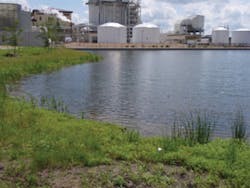The Minnesota Municipal Power Agency’s Faribault Energy Park (FEP) is an on-demand, clean burning, natural gas and biomass energy production facility located in south central Minnesota. As most power plants do, the facility requires large quantities of water for cooling and steam production. To provide this, facility designers Avant Energy Services needed a reliable source of water that would not deplete the groundwater aquifer. In an effort to reduce withdrawals from the Jordan Aquifer, it was desirable to combine used cooling water with stormwater runoff and reuse the water for cooling. At the same time, designers wanted to create a natural park setting to provide an amenity within the community for visitors and school groups. A constructed wetland system was conceptualized, designed, constructed, and planted as the solution that would best serve these purposes. This article discusses the vision for the wetland system, the merging of industry and ecology, the design process, the creation of a wetland park, and the management of this innovative ecological system.
Not Your Typical Power Plant
While we typically think of power plants as large industrial facilities without human vision or creativity behind them (definitely not places that attract visitors), this is not the case for the FEP site. At the onset of the power plant’s conceptual design, a different kind of system was envisioned. The power plant owners desired an aesthetically pleasing infrastructure and a system that was integrated with a natural water reuse system. The goals of this natural wetland system were twofold. The first was to provide for the power plant’s cooling water requirements, and the second was to create a system attractive to the power plant operators and to the local community.
Often engineers design systems simply for function. This results in well-operating systems that can lack human attraction or interest. How many of us would like to live next to a wastewater treatment plant, a highway intersection, or, in this case, a power plant? The FEP owners challenged the projects’ engineers to think outside of the box to provide both function and aesthetics. Rather than a series of square wetland cells with one type of wetland plant, the system was designed with natural edges and a varied planting scheme.
Merging Industry and Ecology
Industry and ecology have been merged both theoretically and literally at the FEP site using the concept of industrial ecology. This approach to industrial design does not necessarily utilize natural or ecological systems in the overall system concept. It looks at an industrial process through the lens of natural system flows.
The basis of industrial ecology is the understanding that in the natural world, waste does not exist. According to a paper by Robert A. Frosch presented at the National Academy of Sciences colloquium on Industrial Ecology in 1992, “The idea of an industrial ecology is based upon a straightforward analogy with natural ecological systems. In nature, an ecological system operates through a web of connections in which organisms live and consume each other and each other’s waste” (Frosch 1992).
While industrial ecology is the process of minimizing system inputs and reusing waste streams as inputs for other processes, the FEP project takes this concept a bit further by utilizing a natural system as part of the overall design.
Designing the Integrated Industrial-Ecological System
In concept, merging industry and ecological principles seems like fluid practice. In reality, the process can be quite complicated. For the FEP water management strategy, ecological approaches were taken to minimize inputs (raw groundwater) and simultaneously reduce or eliminate waste streams (used cooling water). A wetland system was chosen because of its treatment abilities, flexible storage capabilities, and aesthetic values.
The first step in the system design process is to determine a water balance for the site. This involves modeling stormwater inputs, losses to evaporation, and cooling water withdrawals and returns to the system. The water balance helps the designers determine the required storage volume and the maximum drawdown (the largest volume of water needed for cooling and minimal stormwater inputs). The establishment of a water balance also allows the system designers to predict the required supplemental groundwater withdrawals.
The water balance for the site is the foundation on which design decisions are based. After the establishment of this foundation, the iterative design process begins. A number of design elements that interact in sometimes conflicting partnerships must be reconciled during the design process. Some of these elements include plant survivability (plants can typically handle a 2-foot water level bounce) versus maximum wetland drawdown for cooling water uses; the establishment of a healthy natural system versus the need for high-quality water for cooling water purposes; and a simple system versus fully automated controls.
Reconciling or designing these system elements results in both the physical system design and intended operational scheme. The balance between the desired water withdrawal for cooling purposes and the maximum water level bounce results in minimum surface area requirements of the system. Designing both for a healthy, natural system (fish, insects, plants) and for high-quality water requirements results in cooling water intake structures designed to keep the natural components of the wetland in the wetland and to allow clean water to be withdrawn by the power plant. These elements provide constraints for the system and drive the system’s design. The issue of a simple system versus an automated system is not as clear-cut.
Although balancing human needs and those of natural systems can be accomplished through smart design practices, mimicking the self-regulating aspects of nature is not as simple a task. In engineered systems, layers of control result in layers of system complexity and ultimately result in a web of potential system failures. One must consider both the layers of complexity and the level of automation required. In the case of the FEP project, system operators are in direct control of the water level control structures (structure between the various wetland cells of the system) and can choose when to withdraw water for cooling purposes. While this scenario requires additional operator input, it also limits system issues from going unnoticed.
As seen in the example of the FEP site, merging industry and ecology requires system designers to answer many questions on points of integration and to reconcile opposing industrial-system and natural-system needs. In the end, the merging results in systems that are more self-sustaining and that have lower impacts on the surrounding environment. The industrial ecology model provides a framework for viewing human-created systems through a natural system lens. This can also provide opportunities for economic benefit via the repackaging of waste streams into raw materials for other processes.
The Creation of a Wetland Park
Generally, in projects with wetland impacts, wetlands are either created in former upland areas or restored in a previously degraded wetland. Wetland creation is a more difficult process than wetland restoration, as it is completed on land that was not previously a wetland environment. Consequently, several design components need to be considered before beginning the wetland design and construction process. Listed below are the required wetland components and how they were addressed at FEP:
- Water Inputs. Created wetlands need a constant supply of water. This can be provided through surface water sources or groundwater sources. In the absence of a shallow groundwater table, agricultural ditches or streams are often diverted into the wetland creation area to provide a water supply. At the FEP site, water to the wetlands is supplied by cooling water, stormwater gains, inflow from the surficial water table, and, when necessary, from groundwater from a nearby well set in the Jordan Aquifer.
- Soil Substrate. Soil conditions at the wetland site need to be capable of retaining water and providing a suitable organic substrate for wetland plants. Soil conditions at FEP are characterized by clay loam soils that are suitable for wetland plant establishment and water retention. Topsoil was brought in to provide additional organic material for wetland plants.
- Wetland Plants. In the absence of a native seed bank, the creation site needs to be planted with a combination of seed, potted plants, and rootstock brought in from outside sources. It is critical to establish baseline vegetation in the wetland to prevent plant domination by invasive and monotypic species such as reed canary grass and cattails. Information on the wetland plants at FEP is presented in the following sections.
- Upland Buffer. To protect the wetland from pollution from exterior sources and to provide habitat for several wetland/upland species, upland buffer strips are typically required. At FEP, a prairie ecosystem was established in the upland areas as part of the wetland park creation.
Post-Construction Wetland Establishment
Following the water balance and conceptual design completed by Jacques Whitford NAWE and a more detailed engineering design by civil engineers, wetland construction began in June 2007. The final basins were completed mid-July. Jacques Whitford NAWE was then retained as the wetland planting contractor to complete the wetland creation project with the goal of creating a diverse vegetative landscape through the formation of a tiered wetland that satisfied all of the criteria discussed previously. The varying depths constructed in the wetland basins support the variety of wetland species that are typically seen in natural, high-functioning wetlands.
The shallow zone was planted and seeded with emergent wetland vegetation, which requires only saturated soils and can withstand water depths of 1 to 2 feet. In these areas (type 2 and 3 wetlands), a sedge meadow seed mixture consisting of a variety of sedges, bulrushes, and forbs were hand-spread on tilled, saturated soil. The area was then lightly tamped and mulched to protect the seed and the soil from erosion.
In combination with the wetland seed, hardstem bulrush (Schoenoplectus acutus), sweet flag (Acorus americanus), bur-reed (Sparganium eurycarpum), three-square bulrush (Scirpus americanus), and broadleaf arrowhead (Sagittaria latifolia) were planted in 4-inch pots with time-release fertilizers to encourage rapid establishment. These were planted in clusters of similar vegetation and spaced at 1- to 2-foot intervals throughout the wetland zones. The potted plants were obtained from a local nursery, where they were grown in a greenhouse from wetland seed that was harvested in similar climatic conditions as the wetland creation site. The approximately 6,000 potted plants used were about 6 to 8 weeks old at the time of installation and were planted in the type 2 and 3 wetland zones.
Once vegetation establishes in this wetland zone, the high biomass concentration will provide refuge to a wide variety of invertebrates, amphibians, and fish fry. Wading birds also prefer this habitat because of the abundance of prey and the ability to stand in shallow water or perch on emergent plants. Established and potted plants were installed to facilitate the rapid establishment of vegetative zones that provide the habitat discussed previously.
The third type of wetland planting at the FEP site consisted of aquatic species. Submerged plants such as floating-leaved pondweed (Potamogeton natans), water celery (Vallisneria americana), bladderwort (Utricularia sp.), and water lily (Nymphaea sp.) were planted in the type 4 and 5 wetland zones (water depths of 6 inches to 6 feet). The plants came as aquatic rootstock–small portions of plant roots that were harvested out of existing wetlands. Aquatic species require specialized planting techniques such as rockbagging, a practice in which rootstock is placed in a biodegradable bag along with gravel and the bag sinks to the bottom of the wetland. Before the bag degrades and the roots are released, the rootstock is already well anchored into the soil. Water lily, pondweed, and water celery were planted using this method. As bladderwort is a floating plant, its rootstock was planted by placing the root on the water surface. A small raft was used to plant the aquatic species in the center of the wetland to ensure adequate spacing of wetland plants. Approximately 5,000 rootstock plants were installed in the submergent wetland zone.
The deepwater wetland zones provide habitat for fish species. The final design included shelves at 4 feet to 6 feet of depth to facilitate growth of the submerged aquatic plants, such as pondweed. These plants serve as excellent habitat and as a refuge from fish-eating birds. In addition, this kind of deepwater habitat is essential to maintaining stocks of minnows. Mosquito control in the wetland will be greatly facilitated by providing sustainable habitat for minnow species that prey on mosquito larvae. Raising wetland water levels periodically allows fish to more easily invade the thatch zones of emergent wetland vegetation to prey on insect larvae.
Ongoing Wetland Monitoring
To ensure the success of the wetland creation and to meet the requirements of the US Army Corps of Engineers, five years of wetland monitoring is required at the FEP wetland creation site. To date, monitoring activities include biweekly site visits, water level monitoring, invasive species control, photo documentation, annual monitoring reports, and plant species inventories.
At this point, invasive species are not a large problem at FEP; however, a couple of conditions are currently being monitored. Small pockets of reed canary grass (Phalaris arundinacea) have been observed around one wetland, but they are generally in individual clusters or areas that cover less than 10 square feet. Typically, reed canary grass is best controlled by preventing it from seeding and through water level controls. Because raising the water level of the pond is not possible, current control methods include herbicide application and physical removal (mowing or pulling). This has been successful thus far, as reed canary grass populations have decreased dramatically. In addition to reed canary grass, the presence of smartweed (Polygonum sp.) and purple loosestrife (Lythrum salicaria) is also closely monitored. Monitoring during the next couple of years will be crucial to encourage the propagation of the wetland plants and to prevent the spread of invasive plants. If necessary, additional wetland planting or seeding will be initiated to supplement areas with poor vegetative growth.
In Summary
In summary, the four created wetland basins are currently in the beginning stages of conversion to natural wetlands. One year after wetland planting, the wetlands have established large stands of vegetation that will continue to propagate in future growing seasons. Wildlife–including ducks, geese, and other small animals–frequently visit the site, and fish species have thrived in the deepwater environments. Over the next couple of years, the wetland complex will continue to develop into a high-functioning ecosystem that supports diverse flora and fauna. At the same time, this ecosystem serves a practical function in the treatment, storage, and reuse of water for the Faribault Energy Park.


